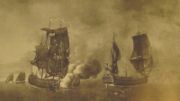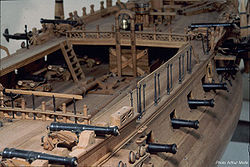| Wikisource has original text related to this article: |
| French frigate Belle Poule (1765) | |
|---|---|
 Fight of Arethusa and the Belle Poule | |
| Career (France) | |
| Name: | Belle Poule |
| Namesake: | Paule de Viguier, baronne de Fonterville |
| Builder: | Bordeaux shipyard |
| Laid down: | March 1765 |
| Launched: | 18 November 1766 |
| Commissioned: | Early 1767 |
| Captured: | 16 July 1780 by the Royal Navy |
| Career (Great Britain) | |
| Name: | HMS Belle Poule |
| Acquired: | 16 July 1780 |
| Out of service: | 1798 |
| Fate: | Broken up in 1801 |
| General characteristics | |
| Class & type: | Dédaigneuse-class frigate |
| Displacement: |
650 tonnes (empty) |
| Length: | 43 metres |
| Beam: | 11.2 metres |
| Draught: | 4.9 metres |
| Sail plan: | Full-rigged ship |
| Complement: | 8 officers + 260 men |
| Armament: | 26 × 12-pounder guns + 4 × 6-pounder guns |
Belle Poule was a French frigate of the Dédaigneuse class, which Léon-Michel Guignace built. She is most famous for her duel with the British frigate Arethusa on 17 June 1778, which began the French involvement in the American War of Independence.
1768 – 1778[]
Belle Poule was built in Bordeaux between March 1765 and early 1767. She served in two campaigns in the West Indies, where due to her good sailing performance she was selected for the first French attempt at covering her hull with copper to resist marine growths.
From 1772 to 1776, she was sent on hydrographic missions, during which the young La Pérouse came to the attention of his superiors.
On 12 December 1776, she left India to return to Brest. At the time, France was not yet engaged in the American War of Independence, but there had been numerous incidents involving French and British ships. Indeed, on 27 April 1777, Belle Poule was chased by a British ship of the line, which she easily evaded to reach Brest.
1778 – 1801[]

Fight of the Belle Poule and Arethusa
In January 1778, Belle Poule was selected to ferry Benjamin Franklin back to America. On 7 January, the British ships of the line Hector and Courageous stopped her and demanded to inspect her. In spite of the overwhelming superiority of the British forces, her captain, Charles de Bernard de Marigny, answered:
| “ | I am the Belle Poule, frigate of the King of France; I sail from sea and I sail to sea. Vessels of the King, my master, never allow inspections | ” |
The British offered apologies and let the frigate sail through. However, opposing winds prevented the ship from crossing the Atlantic, and after 36 days, Belle Poule had to return to Brest. Franklin later sailed to America aboard the Sensible.
When war broke out, Belle Poule was sent on a reconnaissance mission, along with the 26-gun frigate Licorne, the corvette Hirondelle, and the smaller Coureur, to locate the squadron of Admiral Keppel. They encountered the British squadron, which chased them.

Coiffure Belle-Poule
Arethusa caught up with the French and a furious battle ensued. Eventually, Arethusa had to break off the fight, having lost her main mast. The British captured the smaller French ships, but the two frigates escaped the numerous ships of the line pursuing them. Belle Poule lost 30 killed and 72 wounded, among which her captain, Lieutenant Jean Isaac Chadeau de la Clocheterie. Arethusa had eight men killed and 36 wounded.[1] The battle was so famous that ladies of the high society invented the hairstyle "Belle Poule", with a ship on the top of the head.
Between September and October 1778, Belle Poule teamed up with French ship Vengeur and captured 5 privateers. In 1779, the Belle Poule served as coast guard and convoy escort.
Capture[]
On the evening of 14 July 1780 Captain Sir James Wallace of the 64-gun ship of the line Nonsuch was off the Loire where her boats were burning the French frigate Legere.[2] He observed three vessels to the north west, signalling each other and immediately gave chase. At about midnight Nonsuch caught up with one of the three off Île d'Yeu and commenced a two-hour action. When the French vessel struck she turned out to be the Belle Poule. She was armed with thirty-two 12-pounder guns, had a crew of 275 men and was under the command of Chevalier Kergariou-Coatlès.[2][3] In the engagement Belle Poule lost 25 men killed, including Kergariou, 50 other officers and men, including her second captain, wounded. Nonsuch had lost three men killed and ten wounded, two of whom died later.[2] The two French vessels that escaped were the frigate Aimable, of thirty-two 8-pounder guns, and the corvette Rossinolle, of twenty 6-pounder guns.[2]
British service[]

Model by Arthur Molle
She was commissioned in February 1781 into the British Royal Navy, retaining her name. She served for the next 21 months under Captain Philip Patton. On 17 April she, with Berwick, captured the privateer Callonne, under the command of Luke Ryan.[4] Calonne was only two years old, a fast sailer, and well equipped for a voyage of three months and a crew of 200 men. She was armed with twenty-two 9-pounder guns, six 4-pounder guns and six 12-pounder carronades.[5]
Fate[]
The Royal Navy put Belle Poule into ordinary at Chatham in November 1782. She then served briefly as a receiving ship from 1796 before the Admiralty sold her for breaking up in 1801.
Notes, citations and references[]
Notes[]
Citations[]
- ↑ "No. 11886". 22 Jun 1778. https://www.thegazette.co.uk/London/issue/11886/page/
- ↑ 2.0 2.1 2.2 2.3 "No. 12106". 1 Aug 1780. https://www.thegazette.co.uk/London/issue/12106/page/
- ↑ Levot, p.257
- ↑ "No. 12262". 15 Jan 1782. https://www.thegazette.co.uk/London/issue/12262/page/
- ↑ "No. 12192". 29 May 1781. https://www.thegazette.co.uk/London/issue/12192/page/
References[]
- Levot, Prosper (1866) (in French). Les gloires maritimes de la France: notices biographiques sur les plus célèbres marins. Bertrand. http://books.google.com/?id=08O_XGLO43QC.
| Wikimedia Commons has media related to French ship Belle Poule (1765). |
The original article can be found at French frigate Belle Poule (1765) and the edit history here.